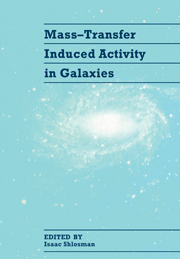Book contents
- Frontmatter
- Contents
- Preface
- List of Participants
- I INTRODUCTION
- II THE INNER PARSEC
- III THE CIRCUMNUCLEAR REGION
- IV GAS DYNAMICS AND STAR FORMATION IN BARRED AND NORMAL GALAXIES
- V NUCLEAR GAS AND LARGE-SCALE PROPERTIES OF AGN AND STARBURST HOSTS
- VI HOST GALAXY-AGN-NUCLEAR STARBURST CONNECTION
- VII GALAXY INTERACTIONS AND INDUCED ACTIVITY
- VIII GAS DYNAMICS IN ELLIPTICALS
- IX AGN AND STARBURST HOSTS AT LARGE REDSHIFTS
- Early AGN and Galaxy Formation (Invited paper)
- Collapses, Collisions, Quasars, and Cosmogony (Invited paper)
- The Evolution of Quasar Host Galaxies
- Evolution of the Galaxy Merger Rate: Counting Pairs in HST Fields (Poster paper)
- Stellar Mass Loss in Ellipticals and the Fueling of AGN (Poster paper)
- Star–Forming Galaxies and Large–Scale Structure (Poster paper)
- X CONFERENCE SUMMARY
- Subject Index
- Object Index
- Author Index
Evolution of the Galaxy Merger Rate: Counting Pairs in HST Fields (Poster paper)
Published online by Cambridge University Press: 05 May 2010
- Frontmatter
- Contents
- Preface
- List of Participants
- I INTRODUCTION
- II THE INNER PARSEC
- III THE CIRCUMNUCLEAR REGION
- IV GAS DYNAMICS AND STAR FORMATION IN BARRED AND NORMAL GALAXIES
- V NUCLEAR GAS AND LARGE-SCALE PROPERTIES OF AGN AND STARBURST HOSTS
- VI HOST GALAXY-AGN-NUCLEAR STARBURST CONNECTION
- VII GALAXY INTERACTIONS AND INDUCED ACTIVITY
- VIII GAS DYNAMICS IN ELLIPTICALS
- IX AGN AND STARBURST HOSTS AT LARGE REDSHIFTS
- Early AGN and Galaxy Formation (Invited paper)
- Collapses, Collisions, Quasars, and Cosmogony (Invited paper)
- The Evolution of Quasar Host Galaxies
- Evolution of the Galaxy Merger Rate: Counting Pairs in HST Fields (Poster paper)
- Stellar Mass Loss in Ellipticals and the Fueling of AGN (Poster paper)
- Star–Forming Galaxies and Large–Scale Structure (Poster paper)
- X CONFERENCE SUMMARY
- Subject Index
- Object Index
- Author Index
Summary
ABSTRACT
Using deep HST/WFC images, originally taken to study faint radio galaxies, we find 81 clear serendipitous galaxy images, of which 34 are pair members. Based on nearby magnitude-limited samples, this is an excess of more than 4σ above the expected number of pair members. We take this result as strong evidence that the galaxy merger rate was higher in the past, and has declined over time.
INTRODUCTION: GALAXY MERGERS AND EVOLUTION
Galaxy interactions and mergers have been implicated as driving galaxy evolution in several ways:
Triggering starbursts, thus making the star-forming history episodic Driving global winds from starbursts, sweeping merger remnants free of gas and dust Transforming galaxy morphology through mergers and tidal impulses Triggering nuclear activity
Counts of local pairs and mergers, plus N-body modelling of orbital decays, suggest that many (perhaps most) present galaxies underwent mergers during cosmic history. This means that the merger rate was probably higher in the past. We are using galaxy and pair counts from deep HST serendipitous fields to constrain the merger rate.
We cannot uniformly trace mergers themselves to large redshifts, because (1) cosmological (1 + z)4 surface-brightness dimming makes the characteristic tidal features too faint for detection and (2) at large redshifts, the disturbed structures can be too small for detection given surface-brightness constraints. We therefore trace the merger rate by studying the evolution of galaxy pairs some of which are the immediate precursors of mergers.
- Type
- Chapter
- Information
- Mass-Transfer Induced Activity in Galaxies , pp. 483 - 484Publisher: Cambridge University PressPrint publication year: 1994

